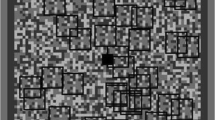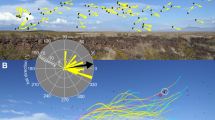Summary
Data on Gyrinus picipes were collected to examine the influence of prey distribution and capture on search path configuration. All paths were analyzed before and after prey capture. Parameters measured were turning angles, step lengths, and step direction. Three indices of search efficiency were calculated: linear displacement, thoroughness, and straightness. Prey distribution had little impact on search configuration. However, prey capture caused significant reductions in step length, linear displacement, and straightness. Thoroughnnes and turning angle increased significantly after prey capture.
A simulation model was developed to analyze influences of search parameters on search efficiency. Search paths, simulated using empirically derived parameters, did not differ from actual search paths indicating that the model accurately describes gyrinid search paths and may be used in these analyses. Actual search paths were compared to a simulated Brownian (random) search. Search paths before prey capture were significantly different from random, but Brownian search can describe search paths after prey capture. Comparisons of simulations using various input parameters indicate that step length has the greatest effect on search paths. Turning angles and direction are important before prey capture but not after.
Similar content being viewed by others
References
Armstrong DP, Gass CL, Sutherland GD (1987) Should foragers remember where they've been? Explorations of a simulation model based on the behavior and energetics of territorial hummingbirds. In: Kamil AC, Krebs JR, Pulliam HR (eds) Foraging behavior. Plenum Press, New York, pp 563–586
Batschelet E (1965) Statistical methods for the analysis of problems in animal orientation and certain biological rhythms. American Institute of Biological Sciences Monograph, Washington, D.C.
Batschelet E (1981) Circular statistics in biology. Academic Press, New York
Bond A (1980) Optimal foraging in a uniform habitat: the search mechanism of the green lacewing. Anim Behav 28:10–19
Brown L, Downhower JF (1988) Analyses in behavioral ecology: a manual for lab and field. Sinauer, Sunderland, MA
Cain ML (1985) Random search by herbivorous insects: a simulation model. Ecology 66(3):876–888
Chandler AEF (1969) Locomotory behavior of first instar larvae of aphidophagous Syrphidae (Diptera) after contact with aphids. Anim Behav 17:673–678
Charnov EL (1976) Optimal foraging, the marginal value theorem. Theor Popul Biol 9:129–136
De Vita J, Kelly D, Payne S (1982) Arthropod encounter rate: a null model based on random motion. Am Nat 119(4):499–510
Gendron RP, Staddon JER (1983) Searching for cryptic prey: the effect of search rate. Am Nat 121(2):172–186
Harkness RD, Maroudas NG (1983) Organizing a search: a modified random-walk model for the nest of an ant (Cataglyphis bicolor). J Physiol 341:73–74
Hassel M (1978) The dynamics of arthropod predator-prey systems. Princeton University Press, Princeton
Hassel MP, Southwood THE (1978) Foraging starategeies of insects. Annu Rev Ecol Syst 9:75–98
Hoffmann G (1983a) The random elements in the systematic search behavior of the desert isopod Hemilepistis reamuri. Behav Ecol Sociobiol 13:81–92
Hoffmann G (1983b) The search behavior or the desert isopod Hemilepistis reamuri as compared with a systematic search. Behav Ecol Sociobiol 13:93–106
Kareiva PM, Odell G (1987) Swarms of predators exhibit “preytax-is” if individual predators use area-restricted search. Am Nat 130(2):233–270
Kareiva PM, Shigesada N (1983) Analyzing insect movement as a correlated random walk. Oecologia 56:234–238
Kolmes SA (1983) Ecological and sensory aspects of prey capture by the whirligig beetle Dineutes discolor (Coleoptera:Gyrinidae). N Entomol Soc 91:405–412
Koopman BO (1980) Search and screening: general principles with historical applications. Permagon Press, New York
Menzel EW, Wyers EJ (1981) Cognitive aspects of foraging. In: Kamil AC, Sargent TD (eds) Foraging behavior: ecological, ethological, and psychological approaches. Garland STPM Press, New York, pp 355–377
Pierce GJ (1987) Search paths of foraging common shrews Sorex araneus. Anim Behav 35:1215–1224
Pyke GH (1978) Are animals efficient harvesters? Anim Behav 26:241–250
Pyke GH (1984) Optimal foraging theory: a critical review. Annu Rev Ecol Syst 15:523–575
Shettleworth SJ (1983) Memory in food-hoarding birds. Sci Am 247:102–110
Smith JNM (1974a) The food searching behavior of two European thrushes: I. description and analysis of search paths Behaviour 48:276–302
Smith JNM (1974b) The food searching behavior of two European thrushes: II. the adaptiveness of search patterns. Behaviour 49:1–61
Sokal RR, Rohlf FJ (1981) Biometry. Freeman, New York
Zimmerman M (1979) Optimal foraging: a case for ranodom movement. Oecologia 43:261–267
Author information
Authors and Affiliations
Additional information
Offprint requests to: D.L. Winkelman at his current address
Rights and permissions
About this article
Cite this article
Winkelman, D.L., Vinyard, G.L. Gyrinid searching tactics: empirical observations and a tactical model. Behav Ecol Sociobiol 28, 345–351 (1991). https://doi.org/10.1007/BF00164384
Received:
Accepted:
Issue Date:
DOI: https://doi.org/10.1007/BF00164384




